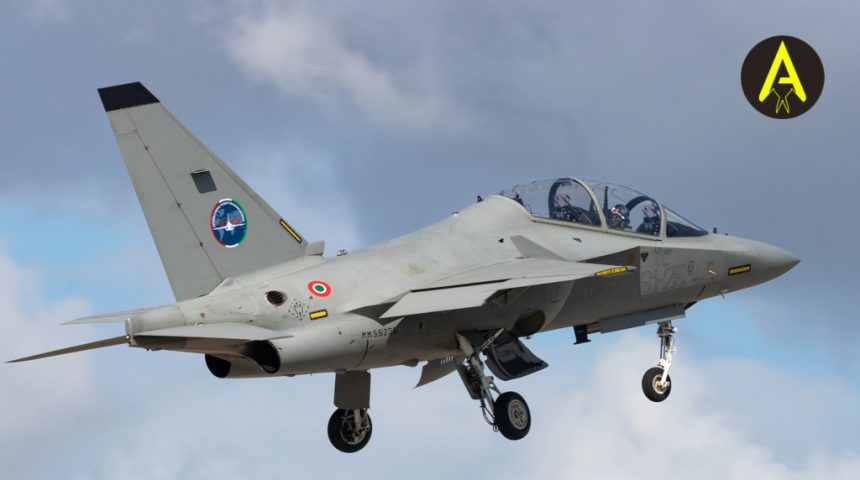We have recently talked to the Chiefs of Staff of the ITAF, RAF, JASDF and RCAF and here’s why the Italian training system, based on the M-346 and already chosen by nine air forces for the training of their future combat pilots, is the world’s most advanced.
As we mentioned in the first part of our report from Lecce-Galatina Air Base, the 61° Stormo (Wing) of the Aeronautica Militare (Italian Air Force, ITAF), is specialized in the training of fighter pilots. In fact, the unit is not only in charge of the common Primary Pilot Training, but also of the Specialized Pilot Training of pilots which will be assigned to fighter aircraft or Remotely Piloted Aircraft, as well as the Lead In to Fighter Training (LIFT) for pilots that will be assigned to 4th and 5th generation fighter aircraft.
Since the introduction into service of the M-346 (T-346A in the official designation of the Italian MOD), the LIFT training offered by the 61° Stormo has been in the international spotlight, with nine countries sending their pilots to train there and many more visiting the airbase to get to know the activities performed there. During our recent visit, we had a chance to see up close the activities of the Phase IV training during their last days at Lecce-Galatina Air Base.
In fact, the T-346 and the LIFT training has just officially relocated to Decimomannu Air Base in Sardinia, where on May 11 the new Italian Air Force/Leonardo International Flight Training School Campus was officially presented. For some months now, the T-346 fleet was divided between the two locations but, now that the works on the new infrastructures are complete, the fleet’s move will be completed.
During the presentation of the new campus, we had a chance to talk with some of the top generals of the air forces that have already selected the IFTS for the training of their future combat pilots.
View this post on Instagram
“The RCAF is excited to be here, we have been planning to join the program for some years”, told us Brig. Gen. Todd N. Balfe, Royal Canadian Air Force (RCAF) Fighter Capability Special Advisor. “We now have an Instructor Pilot who’s been assigned to the IFTS, he’s already begun flying and he’s the first of many Canadians who will be trained here over many, many years. Part of the reasons is necessity, as we are transitioning out of our old training system, we are going to be build a new training system, but we have a gap of 8 to 10 years, where we don’t have our system back in Canada. As we looked around the world, it was quickly apparent to us that IFTS is a world leading training system so we wanted to be here to produce some of the best fighter pilots we could, but also to learn from the system. So as we spend time here with our IPs and student pilots, we will take all the lessons back to Canada where we’ll build our own system. And I will conclude by saying that Gen. Luca Goretti, the Commander of the Italian Air Force, is right: IFTS is the only 5th generation training system in the world.”
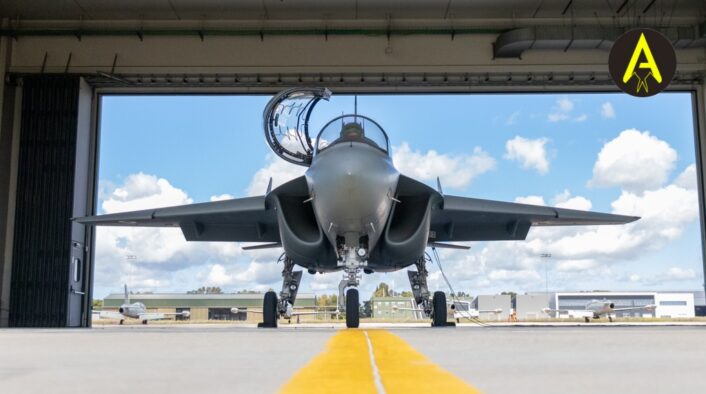
“I got a chance to fly in the M-346 and now that I’ve flown in the aircraft with the Squadron Commander I must say that I was really impressed. Same for our IP, who’s a former F-18 pilot (as I used to be an F-18 pilot): he’s flown the aircraft and carried out various missions in the simulator and he also remarked how similar the M-346 is to the F-18 in terms of flying characteristics: it’s not as fast because it doesn’t have the afterburner, but the rest of the airplane characteristics are remarkably similar as are information displays. He’s impressed with the aircraft, he’s very impressed with the system and training, the simulator and all of the LVC capabilities are truly impressive, in my travels I’ve not seen a system like this in the world, and I think the world is gonna build more systems like this one, because it allows us to train our pilots faster, better and ultimately cheaper.”
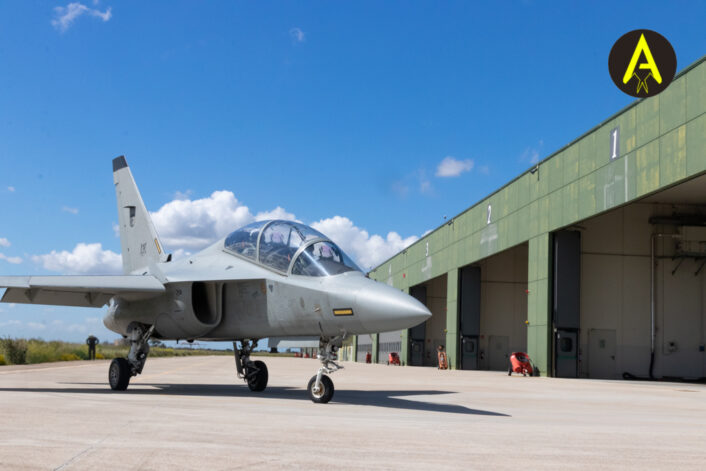
“We are too transitioning to the 5th generation and this is one of the reasons we wanted to be here: I was lucky to be in Amendola in November, when Gen. Goretti hosted the F-35 Air Chiefs Meeting so I got a chance to see the Italian F-35 operations and begin to learn lessons learned and we think that having a training system that builds pilots for the F-35 is incredibly smart. Hence I think with the partnership with Leonardo and CAE, the Italian Air Force is breaking new ground, so we are excited to be here.”
“I’m very much honored and pleased to be invited to this opening ceremony of the IFTS” Gen. Hiroaki Uchikura, Japan Air Self-Defense Force Chief of Staff told us. The CinC of the JASDF expects the school to play an important role breeding new generations of pilots from Japan, Italy and all other participant countries, preparing them for the next generation fighters. Including, GCAP, that Japan jointly develops with Italy and the UK. “In terms of GCAP, our aim is to come up with the best solution by 2035, a platform that meets the requirements coming from the three nations. We are trying to seek a commonality as much as possible.”
Meanwhile, the JASDF, that already operates the F-35, is acquiring the most F-35s of any international customer with a total of 105 F-35As and 42 F-35Bs: “We are going to introduce F-35A and B variants, around 150 aircraft. My gut feeling is that the F-35 is a real game changer. It is so capable that we need to fill the gap between the platform and the pilot gradually.”
On May 13, the Royal Air Force has also joined IFTS: the Italian Air Force and the Royal Air Force Chiefs of Staff signed an agreement for the training (Phase IV) of Student Pilots ) and Instructor Pilots during the AeroSpace Power Conference held in Rome. The arrival of the first two British Student Pilots at the IFTS is scheduled for July and by 2023 there will be four RAF pilots in Sardinia.
Today, during the #AeroSpacePowerConference, signed the
Technical Arrangement between #ItalianAirForce and #Raf for the training of British pilots at the International Flight Training School #IFTS, training reality born with the collaboration of @Leonardo_live pic.twitter.com/hii5RSo3AT
— Aeronautica Militare (@ItalianAirForce) May 13, 2023
According to the ItAF and RAF Chiefs, training will be crucial also in light of the preparation of the two air forces to the 6th generation aircraft. “We need to talk now and look ahead at how we can build our common training to be ready when the new generation aircraft is delivered in 2035. Otherwise, we will have the aircraft but we will not be ready to be operational with the training”, told Gen. Luca Goretti, Commander of the Italian Air Force.
“We’ve done it in the past,” echoes Air Chief Marshal Sir Mike Wigston who was trained by an Italian IP at the Tri-national Tornado Training Establishment (TTTE) at RAF Cottesmore in the past. “This doesn’t mean we will build an exact model like the TTTE in the past but that has shown what we can do if the intent and the willingness is there. These are the sort of things we want to talk about and plan for now so that we are ready in the late 2030s. The Italian Air Force is leading the way when you look at new training establishment at Decimomannnu.”
“In fact, in Deci you will find Japanese, British and Italian future pilots and this is the small track that can bring us to have a common training program put in place for future generation aircraft and aircrews. We need to be prepared, we need to be ready,” says Goretti.
“Deci at the moment is getting the pilots ready for the GCAP or Eurofighter”, says Wigston, “but what’s exiting to me about Deci is the principles which have been applied, and it is a glimpse of the future, in terms of AR (Augmented Reality), Synthetic Training, platforms being used. And it might not be Deci, might not be the systems and aircraft there, but the principles that the Italian Air Force, Leonardo and CAE: that points to how we will internationally do pilot training in the future.”
At the moment, Canada, UK, Germany, Austria, Saudi Arabia, Qatar, Singapore and Japan are the nations which have already elected IFTS for their Phase IV/LIFT training, while many more are about to join the program.
The Phase IV Lead In to Fighter Training
The Phase IV training of the Italian Air Force pilots is based on two pillars: the T-346A advanced training aircraft and its integrated training system, which allow students to conduct real and synthetic training missions in a joint manner, increasing the training value. In fact, modern flight training not only requires advanced aircraft, but also technologically advanced ground training aids, designed in parallel with the flying counterparts for a seamless transition between the two and also able to integrate with each other for the maximum training efficiency.
The introduction into service of the T-346 has been defined as a real “game changer” for the training. Thanks to its features, it’s the ideal system to train future fighter pilots which are not only required to be good proficient pilots, but they also need to manage the entire weapon system, with all its sensors and weapons, in scenarios which are becoming increasingly more complex, less permissive and with plenty of threats.
The pilots are trained under the widely adopted “train as you fight” concept, to better prepare them for operational units. Today’s fighter pilots need to have first order management skills as right now the superiority against adversaries is obtained in the information domain, the fusion of the info from multiple domains and the reaction time. The modern LIFT training highly reflects these needs.
The syllabus developed for the Phase 4 heavily exploits the ground training segment of the M-346 to build these capabilities, with the live flights being the last step of the training and amounting to roughly 50% of the training events. The simulator training is so realistic that can be counted as real flight hours, without losing training effectiveness.
During these nine months of training, the pilots continue to expand the training blocks of the Specialized Pilot Training. In fact, during the Phase III, students are already exposed to Basic Fighter Maneuvers, Basic Air to Ground employment, Defensive Counter Air missions, Air-to-Air Refueling, as well as live fire range missions, in addition the standard contact, instrument, tactical formation training blocks.
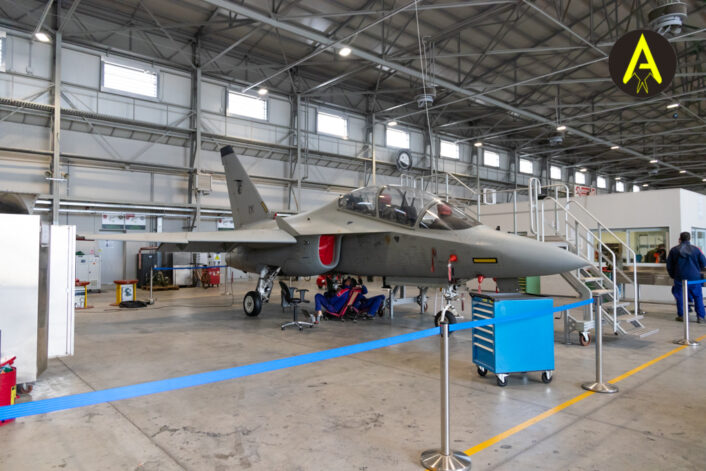
The LIFT training administered by the 212° Gruppo (Squadron) is highly modular, to better adapt to the needs of the air forces who train there. In fact, some countries do not require all modules for the training of their pilots, while Italian pilots are trained on the entire syllabus. Among the modules we find Advanced Air to Air, Advanced Air to Ground, Offensive Counter Air, Defensive Counter Air, Advanced Combat Maneuvers, Quick Reaction Alert, Air to Air Refueling and also an introduction to COMposite Air Operations.
The majority of the training modules is structured as a succession of lessons starting from tutorials on the basic simulators and then moving to more advanced tasks on the other simulators and live flight missions. This kind of approach allows a gradual increment of the student ‘s capabilities, sensibly lowering the live flight hours and thus the training costs, but exposing the pilots to more missions sets in the same time, increasing the level of the training and allowing the student be better prepared for multirole fighter jets.
An important element of the LIFT training is represented by the performance of the aircraft, which are very similar to the ones of 4th and 5th gen aircraft, making almost negligible the transition from the trainer to the final assigned aircraft. This also allowed to decrease the number of flight hours needed by the Operational Conversion Units to train their pilots after LIFT, as many activities can be offloaded from the OCU’s syllabus to the LIFT’s syllabus.
The entire Phase IV course includes a total of approximately 150 simulator and real flight training sessions, flown in all weather conditions, during day and night, with the aid of Helmet Mounted Displays and Night Vision Systems. During this phase, students also have the opportunity to train in real-life shooting scenarios in dedicated training areas in Sardinia, giving them the ability to immediately test in the field the skills acquired.
Decimomannu is, in fact, home to the AWTI (Air Weapons Training Installation), a fully integrated training installation with air-to-air and air-to-ground ranges as well as an EW (Electronic Warfare) range. The school’s move there will give more ease of access to the ranges and training areas at any time, without the need for periodic deployments from Galatina and the subsequent planning and logistic burden.
View this post on Instagram
The M-346 Integrated Training System
As we already mentioned, the M-346 Advanced Jet Trainer revolutionized the training world. In fact, we are not just talking about an aircraft like in the past, but about a fully Integrated Training System which includes both the aircraft and an advanced Ground Based Training System that complements the capabilities of the aircraft and makes the training more efficient.
The GBTS, a fundamental part of the training system, is one of the most complete ever produced, and is composed by the Computer Based Training and a network of simulators which comprises Simulation Based Training, Partial Task Trainer, Full Mission Simulator. The other ground devices are the Real Time Monitoring Station and the Mission Planning and Debriefing Station.
The first level of the simulators is the SBT: nine interconnected stations, each with touchscreen displays and a perfect replica of the HOTAS, which allows the student to train on all fundamental functions of the aircraft. The next step is the PTT, with a compete cockpit and a 180° screen, where the students practice everything they learned so far, including emergencies’ training and advanced training missions. The top level of the simulators is the FMS, made by a perfect replica of the cockpit and an almost 360° screen.
The GBTS allows pilots to learn formation flight, basic maneuvers, advanced combat tactics, both day and night, without the need to get wheels off the ground. This allows a reduction of the flight hours required to compete the training of future fighter pilots of the latest generation aircraft, lowering the costs and improving the efficiency and availability of the fleet for operational tasks.
While the cost reduction is important, the M-346 ITS is unique because it allows the creation of the Live Virtual Constructive environment, an integrated training environment where the real and virtual worlds merge into a single operational scenario in which pilots in the simulators can interact with pilots flying on the real aircraft. This way, future Eurofighter and F-35 pilots can operate simultaneously real flights (live), simulators (virtual), and add at the same time different types of computer-generated threats (Constructive).
View this post on Instagram
LVC allows up to 10 friendly and enemy aircraft to interact as if they were all flying in the same patch of sky, with pilots in the aircraft seeing on their sensors and instruments what pilots in the simulators see on their displays and projector screens. The LVC system is used since the first missions to create challenging training environments, as it allows infinite combinations dictated by the reality of today’s complex operational scenarios.
The T-346s also have an integrated onboard Embedded Tactical Training System (ETTS), which allows the simulation of sensors, weapons, simulated forces so that pilots can interact in real time with a tactical virtual scenery. Among these, we find advanced simulations of radar, datalinks, targeting pods and all kind of sensors used on modern fighters.
While someone still consider the M-346 a derivative of the Joint Italian-Russian Yak/AEM-130, so many things changed and it is now a completely different aircraft. The M-346 has an advanced aerodynamics with high thrust-to-weight ratio and supersonic speed which, coupled with fly-by-wire controls and modern and efficient turbofan engines, makes it a trainer with high performances and high maneuver energy, that put the aircraft on a completely different level compared to other trainers.
Thanks to its performance and capabilities, the T-346 is considered on the same level of the F-16 Fighting Falcon. Because of this, the M-346 has also been used as Aggressor aircraft during air combat training missions with great results since 2015. For an instance, during the Tactical Leadership Programme at Amendola Air Base in 2018, a T-346 was able to outmaneuver and “shoot down” with ease an F-15C during BFMs.
All these capabilities allow the pilots to develop all the skills they need before moving to the Operational Conversion Units. The aircraft’s performance have been further expanded recently, with the increase of the maximum allowed angle of attack from 25° to 30° and the increase of the G limit when the aircraft is equipped with a centerline external fuel tank from 5 G to 6 G.
Let’s not forget that the M-346 is well appreciated also by the U.S. Air Force, which was considering it as replacement for the aging T-38C after multiple visits to Lecce-Galatina Air Base, where officials were impressed after being shown the characteristics of this advanced trainer. The Air Force also certified the training process of the Polish Air Force’s future F-16 and F-35 pilots with the M-346 as analogous to the training on the T-38 up to the IFF (Introduction for Fighter Fundamentals) level.
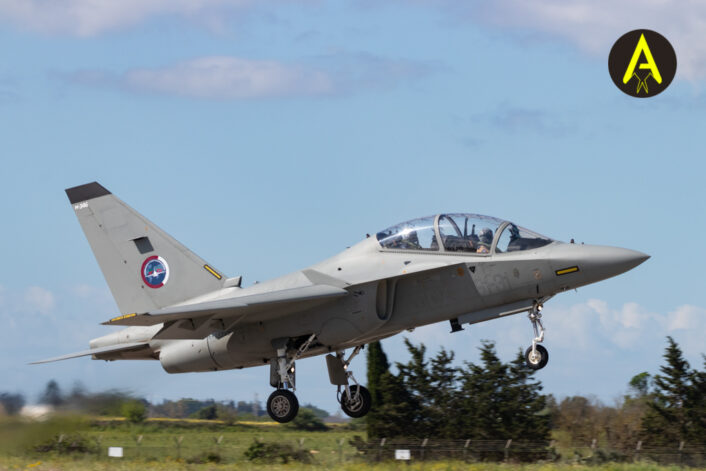
The International Flight Training School
The International Flight Training School project was announced in 2018 at the Farnborough Airshow, when the letter of intent was signed by the ItAF chief of staff and the CEO of Leonardo. The project is articulated in two steps: the first one saw an initial increment of the Phase IV training offer at Galatina AB while works were completed at Decimomannu AB. With the T-346 moving to the new base, the school will be able to train up to 80 new pilots per year, doubling the current offer.
As part of the IFTS, the ItAF has the lead for the management of the operational requirements and of the operations, as well as the upkeep of the quality standards of the flight school. The ItAF is also in charge of the management of the training syllabus, the training of the instructors and the quality control of the exit level of the students.
Leonardo is in charge of the investments for the creation of the school with aircraft and simulators of the latest generation and new ground infrastructures, as well as the operations’ support with technicians that will side with the military personnel. The new campus in Decimomannu takes full advantage of the Sardinian training infrastructures already used for years by the Italian military. A groundbreaking ceremony was held in December 2020 to formally begin construction of the new school, which covers a total area of 130,000 sqm, 35,000 sqm of those are dedicated to buildings.
This truly unique infrastructure, designed around the training needs of future student pilots, boasts a very high degree of technological innovation. An entire newly built building will be dedicated to the Ground Based Training System (GBTS) facilities, with latest-generation simulation systems, inclusive of two Full Mission Simulators and three Part Task Trainer synthetic simulators for emergency management training modules and more advanced training missions, as well as classrooms and offices.
A first training course already started there in July 2022, ahead of the final move of the school from Galatina to Decimomannu this month. The 61° Stormo and IFTS share a fleet of 22 M-346s, four of those are Leonardo-owned and 18 are Italian Air Force T-346As (as the M-346 is designated by the Italian MOD Mission Design Series).

Six M-346Bs joined the IFTS fleet recently, belonging to the Qatar Emiri Air Force, as shown by the Qatar flag which encircles the IFTS emblem on the tail. The M-346B is externally identical to the T-346A, but presents a different avionics configuration. Among the differences there are, for an instance, the removal of voice commands and the encrypted NATO-standard Mode 4 Identification Friend of Foe, as well as other changes.
Leonardo and CAE, through the joint venture “Leonardo CAE Advanced Jet Training”, provide technical-logistic support to the International Flight Training School, including full maintenance and operation of the M-346 aircraft and its Ground-Based Training System, as well as operation of IFTS base facilities. The integrated support optimises the management of fleets and simulators for maximum operability, including the advanced full-mission simulator jointly developed by Leonardo and CAE.
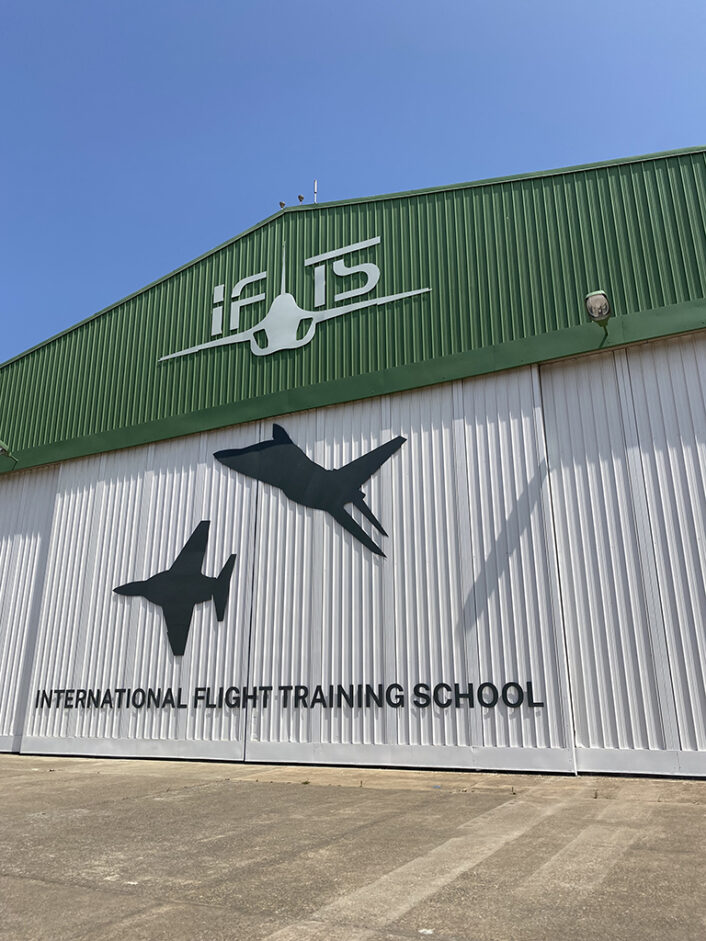
The IFTS has already become internationally renowned, throughout its first years of operations, as one of the most advanced and state-of-the-art flight schools for the training of future fighter jet pilots. The school is now an international reference for Advanced LIFT to better prepare pilots that will fly on front-line fighters of 4+ and 5th gen, like the Eurofighter Typhoon and the F-35.
The IFTS students will be followed throughout their training by a team of 40 instructors, both military and civilian, while flying more than 8,000 flight hours per year on the M-346 Master and as many in the advanced flight simulators, for about a 1:1 ratio between real and simulated flight hours. The school exploits the ItAF’s extensive know-how in the training sector and the national industry’s excellence in the integrated training systems.
As we reported in 2021, Greece is also creating a joint international school with Israel at Kalamata Air Base, home of the 120th Air Training Wing. Elbit Systems has been selected for the creation of the school and will be in charge of the supply and operation of ten M-346 trainers, as well as the maintenance of the HAF T-6 Texan II fleet. Gen. Goretti says the two schools will not compete with each other: there is a huge demand for advanced training that is impossible to meet by one school only. On the contrary, considering that both will use the same platform, there could be an exchange of information from which both will be able to benefit.

